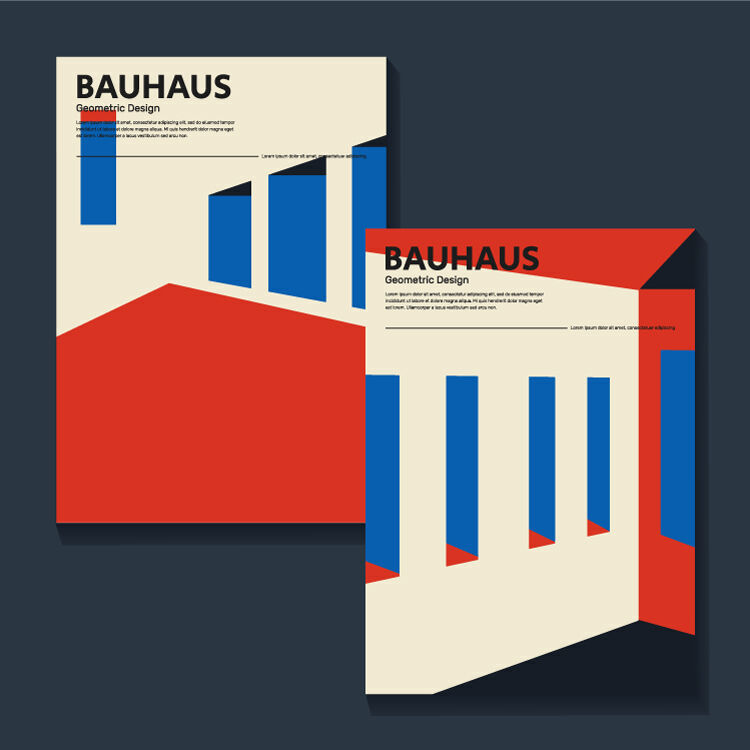Make Your Brochures Stand Out with These 5 Tips from Art Movements and Historical Designs
Written By: Leslie Taylor | Article Date: March 24, 2023
Brochures are staples at events, brick-and-mortar stores, and direct mail materials. But for potential customers to read your message, you need a design that lends credibility to your business and convinces readers to act.
Historical art movements and iconic designs are excellent references for creating effective brochures. They provide a blueprint and methods that effectively capture an audience's attention. Check out the design inspiration from these timeless art movements and famous creations.
5 Tips for Your Brochures from Historical Movements and Designs
1
Bauhaus Movement: Typography should be rational, clear, and legible.

See how this cover design emphasized its title with a larger and bolder font size, the subject matter of ‘Geometric Design’ in a medium size, then the longer details in the smallest font.
Modern design and contemporary architecture attribute many of its principles to The Bauhaus, a small but quite influential school in Germany that operated for 14 years. Bauhaus believed in training students equally in the arts and in craftsmanship. Among Bauhaus' teachings was rational, clear, and legible typography that removed decorative elements and applied hierarchy with lowercase and uppercase text. They also advocated for the sans serif type's appeal and usefulness.
Use visual hierarchy in your brochure's text to apply the Bauhaus’ typography principle. The words or phrases in larger sizes will cue the readers where to start reading and help them navigate the rest of your content. When choosing a font, select the easiest to read and avoid the ones with decorative elements so customers can absorb the brochure’s essential information easily.
2
British Railway Travel Posters: Show a slice of life in your images.
Public and private art collections have displayed the British Railway travel posters, and for good reason. Artists were commissioned by railway companies to create designs that encouraged day trips among workers. The market was open for short vacations after workers gained holiday leaves legally in 1939.
Among the earlier artists commissioned for these posters was John Hassall. To introduce the travel destination, Hassall put an image at the poster's center and reduced the amount of text. Multiple posters reprinted and copied the image on his most famous poster, Skegness is So Bracing.
The same method works for brochures. After all, scanning through several images is easier compared to reading long text. The images also capture your message's essential details without overwhelming the reader. Following the cues from Hassall's British Railway posters, select photographs that show customers using your product like how his famous Skegness is So Bracing poster has a fisherman skipping across the beach. For example, realtors can show a family relaxing in a living room, while an activewear brochure could show women and men doing workouts in their apparel.
3
The Original Apple Macintosh Brochure: Clearly state how the product benefits the customer.
The 1984 Apple Macintosh brochure employs effective messaging that the company still communicates in its website and other digital assets to this day. The brochure cover starts with a problem ("Of the 235 million people in America, only a fraction can use a computer") and then offers the Macintosh as the solution on the second page with the headline, "Now there's Macintosh. For the rest of us."
The rest of the brochure depicts how accessible the computer is and how easy it is for everyone to use: "If you can point, you can use a Macintosh." The images also match the header text per page. To create equally effective copy on your brochure, consider the problem or need your product will solve. Then, come up with a phrase or sentence that succinctly states your item's benefits, as Macintosh did in its clever brochure.
4
Pop Art: Use bold colors and a series of the same image.
The pop art movement emerged in the 1950s and lasted well into the 1960s, with artists like Andy Warhol incorporating popular culture into their work. His screen-printed portraits of Marilyn Monroe in 1967 show the movement's use of a repeated image series. Other prominent techniques pop art is known for are dotted graphics or images, bright colors, and bold typography all of which are still seen today as inspiration and case studies for many seasoned and budding artists.
You see, bright colors immediately capture your reader's attention and can be used as the palette for your entire brochure. If you're looking for a fresh take to showcase your product, a repeated image series can help you present it in a new light. Check out how this brochure on an Andy Warhol exhibit incorporates pop art in its layout with iterations of the same image in bold hues.
5
Art Nouveau: Distinguish your brochure with floral motifs and curved lines
Art Nouveau is French for "New Art," a decorative art style from Europe that lasted from 1890 until 1910. The movement is most famous for its floral motifs, curved and linear lines, and asymmetrical layout in architecture, furniture, and paintings. Contemporary artists and designers continue to apply floral patterns and the movement's use of lines.
Your brochure can focus on plants and flowers if it matches your brand's image, or you can find a way to incorporate floral details to establish contrast. Draw inspiration from the floral patterns and curved lines on the wedding invite below. The decorative Art Nouveau elements frame the text, which shifts attention to the brochure's title page or main headlines.
Customize a Brochure Design You’ll Be Proud Of
Brochures are valuable in promoting and detailing your products or services to customers. But to compete against other printed materials and digital promotions, you need a clear, smart, and effective brochure design to deliver your message. Explore how to apply the tips from historical art movements and company designs in your next brochure.

